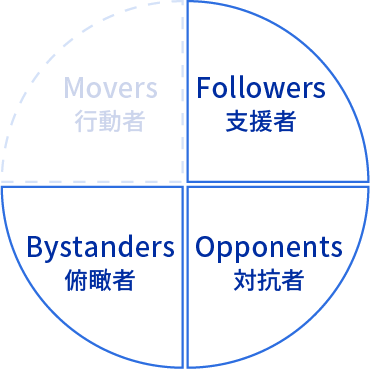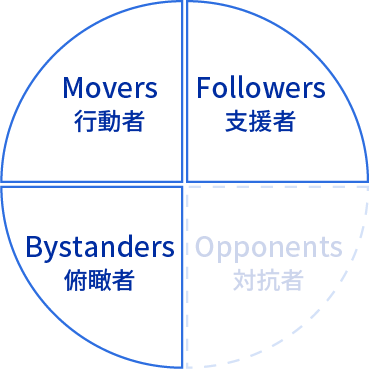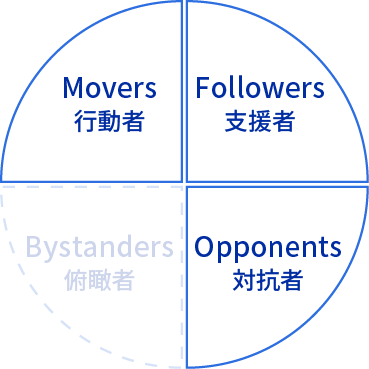Recently, We think a lot about designing programs for workshops that utilize the “4 player model”. In this article, We would like to explain the “4 player model”.

What is the “4 player model”?
The “4 player model” divides the roles of participants into four categories: “Movers,” “Followers,” “Opponents,” and “Bystanders”. It is believed that when people with these characteristics are all together, communication becomes more active and idea creation is promoted. It is also said to maximize group dynamics.

Who proposed the “4 Player Model”?
“4 player model” was proposed by David Kantor, a well known American systems psychologist who has published many books on the subject. The quotes in this article are taken from David Kantor’s words.
Four categories of “4 player model”
Movers
They move a team along.
David Kantor
Movers are those who take on a leadership role in moving and leading a team or group. They speak and act proactively, and often act as facilitators.
Followers
They support the initiative.
David Kantor
Followers don’t often speak or act actively on their own, but they support the initiative of Movers and groups.
Opponents
They provide critical feedback.
David Kantor
Opponents are those who are willing to provide critical feedback on opinions and ideas generated in the dialogue. Criticism can cause discussions to stagnate, but if it is productive criticism (e.g., suggestions for improvement), it can be an important opinion that leads to revision and improvement of ideas.
Bystanders
They often observe the team and its processes from the sidelines.
David Kantor
They often observe the team and its processes from the sidelines. Bystanders are people who watch the team from a bird’s eye view and ponder ideas and processes without taking an active stance. They not only judge and consider opinions and ideas objectively, but also play a role in overall management by grasping the process and degree of progress when working backwards from the group’s objectives and goals. This applies to people who like to serve as timekeepers in group discussions.
What happens if the four players are not aligned?
David Kantor explains what happens when each role of the “4 player model” is missing.
Without Movers

There is no Direction.
David Kantor
Without movers to actively guide the team, the team will lose sight of its purpose and goals, and discussions will stagnate.
Without Followers

There is no Completion.
David Kantor
If there are no followers, there is no completion, and all discussions and ideas become self assertion. If innovation is the accumulation of small ideas, then a team without followers will not be able to accumulate ideas and will not be able to achieve there goals.
Without Opponents

There is no Correction.
David Kantor
Opponents are a nuisance to movers because they take a critical stance. Without opponents, ideas are not revised and improved, and high quality output are not created.
Without Bystanders

There is no Perspective.
David Kantor
Without bystanders, there is no one to grasp the whole picture or think backwards from the objective to allocate resources, which increases the risk of missing something important because they are sometimes too focused on small things. Because they cannot see things from a bird’s eye view, they cannot see the whole picture.
Can player model be changed?
A question that often comes up is, Is the player model immutable because it is personality?. We think it’s not immutable. For example, when participating in a workshop, it is ideal to be able to change there role according to the surrounding environment. While each of us is aware of our own player model, we can challenge ourselves by saying, “Let’s play a different player model this time. We can improve the motivation of the participants and maximize the group dynamics.
How does understanding four player model change the dialogue?
When each person recognizes his or her role, it becomes an opportunity to try to understand, “Maybe He/She is thinking this way,” or “Maybe His/Her silence means that he/she is not just watching from the sidelines, but is thinking about things from a bird’s eye view as a bystander. It is believed that when four players come together, Group Dynamics is created and creative discussions are born.
At the end
In order to facilitate workshops and group discussions, and to find ideas and solutions that surprise people, it is important to understand the “4 player model”. I hope that consultants and students who are looking for a job will also understand the “4 player model” and apply it to their practice.